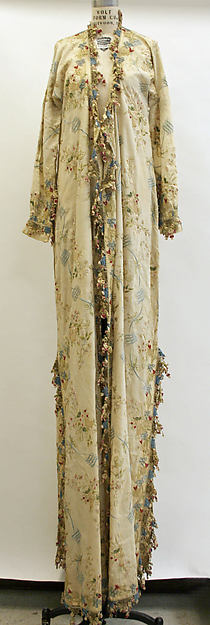And they're our next project.
I mentioned in the last post how I had magically enough fuchsia silk to pull one off without having to fork out an insane amount of money. (I am not near the fabric district anymore. There's no negotiations on prices here). I also mentioned how I managed to find an extant example in a very similar color (albeit it was a silk damask with a floral pattern, not plain silk, but I'll remedy that later).
But the extant garment is plain and relies an awful lot on the trim and pattern of the fabric to liven it up, and I'm not sure I can do that with this plain silk.
Pretty, but without the pattern, would it FEEL the same? Probably not so glorious
Also, it's just not glorious enough. This entari should be eye-popping, really the design should be deserving of it's catchy color. This color is not for the every-day wearer. It belongs to someone from the Dolmabahçe Palace. And it should have a cut that represents that.
So that's what we're going to look at in this post: Entaris. Lots of them. I'll do my best to document them, but a lot of them are old pictures from way back when that I just have because someone emailed them to me.
First off we have one from the Met Museum. I'm using this as an example to show how Museums, even great ones, aren't always so good at dating things outside of their specialties.
Now here's the issue. The Met gives us a HUGE date of 139 years where this entari could have been from. They also have not labelled it as anything but a "robe", and throughout the collections seem, to be throwing around words like "yelek" "caftan" "clogs" "slippers" and "sandals" to whatever they feel like.
There are entaris listed as yeleks, yeleks listed as caftans, and caftans labelled as yeleks.
Add to it, hamam shoes are called anything from clogs to sandals to slippers.
So it's hard to use this site as a good resource for "Oriental" artifacts short of just looking at them for pretty.
However, I HAVE seen this type of entari before, and I've seen it in Istanbul in fact. So I can, because of this, get a much better date on it.
So let's break it down with the characteristics:
It exhibits a disproportionately long bottom/hem. One that would, on the wearer, drag across the floor if not tucked up into something.
It is "straight" cut down the center. By that, I mean that it does not have any special trimming in the front of it that would expose the breasts or chest area. It simply continues straight down.
The sleeves appear to be slit to a small extent and close with a cuff.
The trim is "Armenian Lace", along with some emphasized detail patterns on the gown. Now Armenian lace is a type of 2 or 3 dimensional embroidery/single needle lace-making. It's called Armenian lace because, as far as I know, it's been made in the region of Armenia for thousands of years.
So these are our hallmarks, and this lets me know that this dress is most definitely from the later 19th century, but probably no later than prior to WWI.
Here are some other pretties from the same era.
Pretty display of women dressed in Ottoman clothes from the Sadberk Hanim Museum via
Another set of Entaris from the Sadberk Hanim. This one's website seems to be forever lost though.
Probably also the Sadberk Museum via
Detail of the Yellow Entari in the first Sadberk Hanim picture from The Gemini Post
So I think I've decided. We'll be making a hybrid of these last two plus the first one. Hopefully things will turn out well!








No comments:
Post a Comment